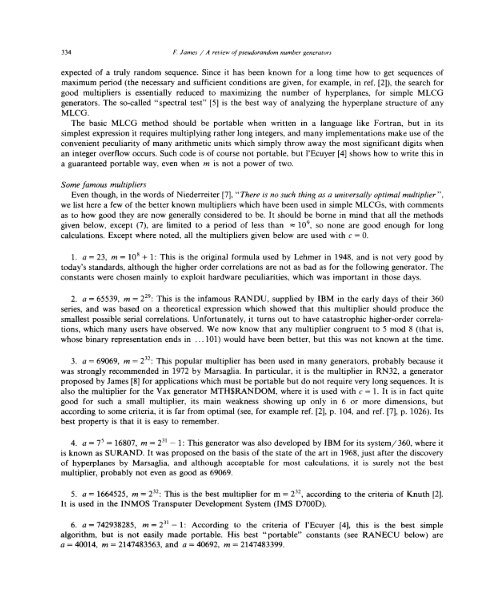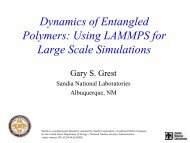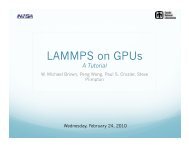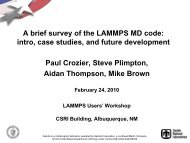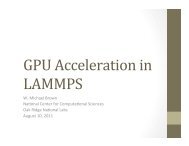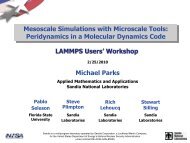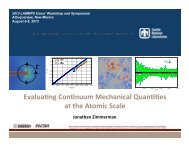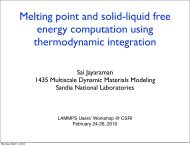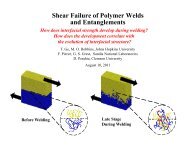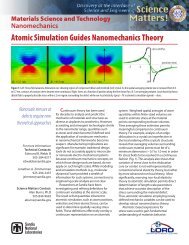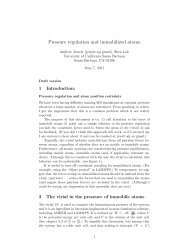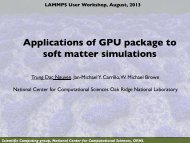A review of pseudorandom number generators - Lammps
A review of pseudorandom number generators - Lammps
A review of pseudorandom number generators - Lammps
You also want an ePaper? Increase the reach of your titles
YUMPU automatically turns print PDFs into web optimized ePapers that Google loves.
334 F. James / A <strong>review</strong> <strong>of</strong><strong>pseudorandom</strong> <strong>number</strong> <strong>generators</strong><br />
expected <strong>of</strong> a truly random sequence. Since it has been known for a long time how to get sequences <strong>of</strong><br />
maximum period (the necessary and sufficient conditions are given, for example, in ref. [2]), the search for<br />
good multipliers is essentially reduced to maximizing the <strong>number</strong> <strong>of</strong> hyperplanes, for simple MLCG<br />
<strong>generators</strong>. The so-called “spectral test” [5] is the best way <strong>of</strong> analyzing the hyperplane structure <strong>of</strong> any<br />
MLCG.<br />
The basic MLCG method should be portable when written in a language like Fortran, but in its<br />
simplest expression it requires multiplying rather long integers, and many implementations make use <strong>of</strong> the<br />
convenient peculiarity <strong>of</strong> many arithmetic units which simply throw away the most significant digits when<br />
an integer overflow occurs. Such code is <strong>of</strong> course not portable, but l’Ecuyer [4] shows how to write this in<br />
a guaranteed portable way, even when m is not a power <strong>of</strong> two.<br />
Some famous multipliers<br />
Even though, in the words <strong>of</strong> Niederreiter [7], “There is no such thing as a universally optimal multiplier “,<br />
we list here a few <strong>of</strong> the better known multipliers which have been used in simple MLCGs, with comments<br />
as to how good they are now generally considered to be. It should be borne in mind that all the methods<br />
given below, except (7), are limited to a period <strong>of</strong> less than iO~,so none are good enough for long<br />
calculations. Except where noted, all the multipliers given below are used with c = 0.<br />
1. a = 23, m = 108 + 1: This is the original formula used by Lehmer in 1948, and is not very good by<br />
today’s standards, although the higher order correlations are not as bad as for the following generator. The<br />
constants were chosen mainly to exploit hardware peculiarities, which was important in those days.<br />
2. a = 65539, m = 229: This is the infamous RANDU, supplied by IBM in the early days <strong>of</strong> their 360<br />
series, and was based on a theoretical expression which showed that this multiplier should produce the<br />
smallest possible serial correlations. Unfortunately, it turns out to have catastrophic higher-order correlations,<br />
which many users have observed. We now know that any multiplier congruent to 5 mod 8 (that is,<br />
whose binary representation ends in . .. 101) would have been better, but this was not known at the time.<br />
3. a = 69069, m = 232: This popular multiplier has been used in many <strong>generators</strong>, probably because it<br />
was strongly recommended in 1972 by Marsaglia. In particular, it is the multiplier in RN32, a generator<br />
proposed by James [8] for applications which must be portable but do not require very long sequences. It is<br />
also the multiplier for the Vax generator MTH$RANDOM, where it is used with c = 1. It is in fact quite<br />
good for such a small multiplier, its main weakness showing up only in 6 or more dimensions, but<br />
according to some criteria, it is far from optimal (see, for example ref. [2], p. 104, and ref. [7], p. 1026). Its<br />
best property is that it is easy to remember.<br />
4. a = 75 = 16807, m = 231 — 1: This generator was also developed by IBM for its system/ 360, where it<br />
is known as SURAND. It was proposed on the basis <strong>of</strong> the state <strong>of</strong> the art in 1968, just after the discovery<br />
<strong>of</strong> hyperplanes by Marsaglia, and although acceptable for most calculations, it is surely not the best<br />
multiplier, probably not even as good as 69069.<br />
5. a = 1664525, m = 232: This is the best multiplier for m = 232, according to the criteria <strong>of</strong> Knuth [2].<br />
It is used in the INMOS Transputer Development System (IMS D700D).<br />
6. a = 742938285, m = 231 — 1: According to the criteria <strong>of</strong> l’Ecuyer [4], this is the best simple<br />
algorithm, but is not easily made portable. His best “portable” constants (see RANECU below) are<br />
a = 40014, m = 2147483563, and a = 40692, m = 2147483399.


